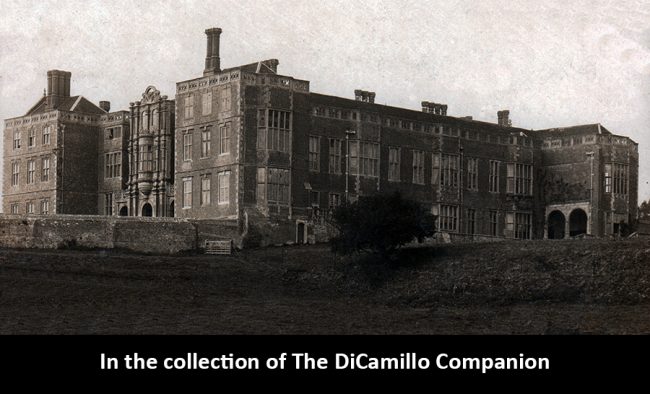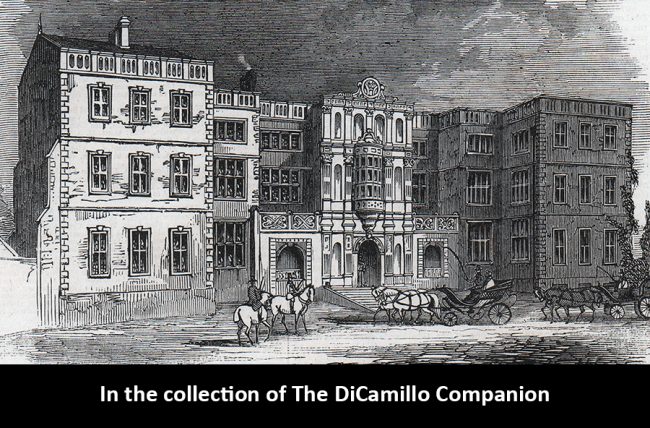
The house from a 1919 postcard

The house from an 1845 engraving
Earlier Houses: The existing house incorporates walls of an earlier house on the site that was once owned by Henry VIII.
Built / Designed For: Lord Zouche
House & Family History: Built by Edward la Zouche, 11th Baron Zouche, in the early 17th century, the three-story red brick Bramshill is one of the largest Jacobean houses in England and a good example of the influence of the Italian Renaissance in Britain. Lord Zouche is famous for being the only commissioner at the trial of Mary, Queen of Scots, who dissented against the judgment and subsequent death sentence that was passed against the queen. In 1620, very likely because of Lord Zouche’s refusal to vote against his mother’s death, King James I stayed at Bramshill (James I's son, Charles I, stayed at Bramshill in 1630). In 1621, George Abbot, archbishop of Canterbury, came to Bramshill to consecrate a chapel for Lord Zouche. During his stay the archbishop participated in a stag hunt, where he accidentally killed a gamekeeper. Abbot is the only archbishop of Canterbury to have ever killed a man. During World War II the house served as a maternity home for evacuee mothers from Portsmouth. In 1953 Bramshill was acquired by the British government, who used the house as a police college from the 1950s until 2013. In July of 2013 the Home Office listed the house, together with 262 acres of land, for sale for £25 million; it was sold in August 2014 to property developer City & Country for £20 million. City & Country subdivided the land and listed Bramshill House, together with 92 acres, for sale for £10 million in 2018. Bramshill, which is supposedly home to 14 different ghosts, is reputedly one of the most haunted houses in England. The house's entrance facade was the inspiration for Darlington in Mahwah, New Jersey, built between 1901 and 1907 by James Brite for George Crocker. Darlington, with 21 bedrooms and 26 baths, was itself listed for sale for $40 million in 2020. Bramshill House has been abandoned since 2014.
Comments: Pevsner, in "The Buildings of England: Hampshire and the Isle of Wight," calls Bramshill "among the most fanciful pieces of Jacobean design in the country."
Garden & Outbuildings: An 18th century gatehouse, with two three-storied turrets and a battlemented center, is extant.
John Bernard (J.B.) Burke, published under the title of A Visitation of the Seats and Arms of the Noblemen and Gentlemen of Great Britain and Ireland, among other titles: Vol. II, p. 46, 1853. 2.S. Vol. II, p. 164, 1855.
John Preston (J.P.) Neale, published under the title of Views of the Seats of Noblemen and Gentlemen in England, Wales, Scotland, and Ireland, among other titles: Vol. II, 1819.
Country Life: XIV, 54, 1903. LIII, 758, 818, 852 plan, 886, 1923. LXXVIII, 168, 1935.
Title: Buildings of England: Hampshire and the Isle of Wight, The
Author: Pevsner, Nikolaus; Lloyd, David
Year Published: 1967
Reference: pgs. 138-140
Publisher: London: Penguin Books
ISBN: NA
Book Type: Hardback
Title: Country Life (magazine)
Author: NA
Year Published: NA
Reference: Jan 31, 2002, pg. 86
Publisher: Bath: Future plc
ISBN: NA
Book Type: Magazine
House Listed: Grade I
Park Listed: Grade I
Past Seat / Home of: Edward la Zouche, 11th Baron Zouche and 12th Baron St. Maur, early 17th century. Sir John Cope, early 18th century. Arthur Ronald Nall Nall-Cain, 2nd Baron Brocket, 20th century. King Michael and Queen Anne of Romania, 20th century.
Current Ownership Type: Individual / Family Trust
Primary Current Ownership Use: Unoccupied
House Open to Public: No
Historic Houses Member: No